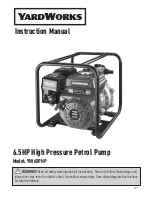
10
equipment for the purpose of designating its voltage class
and for the purpose of defining the minimum and maximum
voltage at which the equipment will operate.
Utilization Voltage - The voltage of the line terminals of the
equipment at which the equipment must give fully satisfactory
performance. Once it is established that supply voltage will
be maintained within the utilization range under all system
conditions, check and calculate if an unbalanced condition
exists between phases. Calculate percent voltage unbalance
as follows:
Three Phase Models Only
HOW TO USE THE FORMULA:
EXAMPLE: With voltage of 220, 216, and 213
1) Average Voltage = 220 + 216 + 213 = 649 / 3 = 216
2) Maximum Voltage Deviations from Average Voltage = 220 - 216 = 4
Percent voltage unbalance MUST NOT exceed 2%.
3) Percent Voltage Unbalance = 100 x = = 1.8%
4
216
400
216
3) PERCENT VOLTAGE
UNBALANCE
2) MAXIMUM VOLTAGE DEVIATIONS
FROM AVERAGE VOLTAGE
1) AVERAGE VOLTAGE
=
100
x
AIR FLOW ADJUSTMENTS
When the final adjustments are complete, the current draw of
the motor should be checked and compared to the full load
current rating of the motor. The amperage must not exceed
the service factor stamped on the motor nameplate. The total
airflow must not be less than that required for operation of the
electric heaters or the furnace.
If an economizer is installed, check the unit operating balance
with the economizer at full outside air and at minimum outside air.
NOTE: Never run CFM below 300 CFM per ton, evaporator
freezing or poor unit performance is possible.
EEM Motor
Adjust the CFM for the unit by changing the position of the low
voltage leads on the motor terminal block. Green is for Fan
Only. Yellow is for Cooling and Heat Pump Heating. Refer to
Appendix A for blower performance at each speed tap. NOTE:
If more than one lead is energized simultaneously, the motor
will run at the higher speed.
Refrigeration System Checks
This unit is equipped with a piston type metering device.
Ensure the hold-down bolts on the compressor are secure
and have not vibrated loose during shipment. Check that the
vibration grommets have been installed and visually check
all piping for damage and leaks and repair if necessary. The
entire system has been factory charged and tested, making
it unnecessary to field charge. Factory refrigerant charge is
shown on the unit’s nameplate.
To confirm charge levels or, if a leak occurs and charge needs
to be added to the system, it is recommended to evacuate
the system and recharge refrigerant to the unit’s nameplate
specifications. This unit has been rated in the cooling mode at the
AHRI rated conditions of: indoor (80°F db/67°F wb) and outdoor
(95°F db). While operating at this condition, the superheat should
range from 9°F to 11°F for each refrigeration circuit measured at
the suction service port located near the compressor.
Start-Up Procedure and Checklist
Begin with power turned off at all disconnects.
Air Conditioning Start-Up Procedure
1.
Turn thermostat system switch to “Cool,” and fan switch
to “Auto” and turn temperature setting as high as it will go.
2.
Inspect all registers and set them to the normal
open position.
3.
Turn on the electrical supply at the disconnect.
4.
Turn the fan switch to the “ON” position. The blower
should operate after a 7 second delay.
5. Turn the fan switch to “Auto” position. The blower should
stop after a 65 second delay.
6.
Slowly lower the cooling temperature until the unit starts.
The compressor, blower and fan should now be operating.
Allow the unit to run 10 minutes, make sure cool air is
being supplied by the unit.
7. Turn the temperature setting to the highest position,
stopping the unit. The indoor blower will continue to run
for 65 seconds.
8. Turn the thermostat system switch to “OFF” and
disconnect all power when servicing the unit.
Heat Pump Start-Up Procedure
9.
Check the cooling mode for the heat pump in the same
manner as above. The reversing valve is energized when
the thermostat is placed in the cooling position. A clicking
sound should be noticeable from the reversing valve. By
lowering the temperature setting to call for cooling, the
contractor is energized. The compressor, blower and fan
should then be running. After the cooling mode is checked
out, turn the thermostat system switch to “OFF”
10.
Turn the thermostat system switch to “HEAT” and fan
switch to “AUTO”.
11.
Slowly raise the heating temperature setting. When
the heating first stage makes contact, stop raising the
temperature setting.. The compressor, blower and fan
should now be running with the reversing valve in the
de-energized (heating) position. After giving the unit time
to settle out, make sure the unit is supplying heated air.
12.
If the outdoor ambient is above 80°F, the unit may trip on
its high pressure cut out when on heating. The compressor
should stop. The heating cycle must be thoroughly
checked, so postpone the test to another day when
conditions are more suitable but-DO NOT FAIL TO TEST.
If the outdoor ambient is low and the unit operates
properly on the heating cycle, you may check the pressure
cutout operation by blocking off the indoor return air until
the unit trips.
Summary of Contents for DTC Series
Page 18: ...18 APPENDIX B ELECTRICAL DATA ...











































